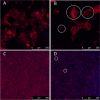Oncopig bladder cancer cells recapitulate human bladder cancer treatment responses in vitro
- PMID: 38469237
- PMCID: PMC10926022
- DOI: 10.3389/fonc.2024.1323422
Oncopig bladder cancer cells recapitulate human bladder cancer treatment responses in vitro
Abstract
Introduction: Bladder cancer is a common neoplasia of the urinary tract that holds the highest cost of lifelong treatment per patient, highlighting the need for a continuous search for new therapies for the disease. Current bladder cancer models are either imperfect in their ability to translate results to clinical practice (mouse models), or rare and not inducible (canine models). Swine models are an attractive alternative to model the disease due to their similarities with humans on several levels. The Oncopig Cancer Model has been shown to develop tumors that closely resemble human tumors. However, urothelial carcinoma has not yet been studied in this platform.
Methods: We aimed to develop novel Oncopig bladder cancer cell line (BCCL) and investigate whether these urothelial swine cells mimic human bladder cancer cell line (5637 and T24) treatment-responses to cisplatin, doxorubicin, and gemcitabine in vitro.
Results: Results demonstrated consistent treatment responses between Oncopig and human cells in most concentrations tested (p>0.05). Overall, Oncopig cells were more predictive of T24 than 5637 cell therapeutic responses. Microarray analysis also demonstrated similar alterations in expression of apoptotic (GADD45B and TP53INP1) and cytoskeleton-related genes (ZMYM6 and RND1) following gemcitabine exposure between 5637 (human) and Oncopig BCCL cells, indicating apoptosis may be triggered through similar signaling pathways. Molecular docking results indicated that swine and humans had similar Dg values between the chemotherapeutics and their target proteins.
Discussion: Taken together, these results suggest the Oncopig could be an attractive animal to model urothelial carcinoma due to similarities in in vitro therapeutic responses compared to human cells.
Keywords: Oncopig cancer model; bladder cancer; cisplatin; doxorubicin; gemcitabine; in silico; microarray.
Copyright © 2024 Segatto, Simões, Bender, Sousa, Oliveira, Paschoal, Pacheco, Lopes, Seixas, Qazi, Thomas, Chaki, Robertson, Newsom, Patel, Rund, Jordan, Bolt, Schachtschneider, Schook and Collares.
Conflict of interest statement
LBS, LJ, CB, and KS work for Sus Clinicals, which provides the Oncopig and other pig-based preclinical testing services to customers. The remaining authors declare that the research was conducted in the absence of any commercial or financial relationships that could be construed as a potential conflict of interest. The author(s) declared that they were an editorial board member of Frontiers, at the time of submission. This had no impact on the peer review process and the final decision.
Figures




Similar articles
-
Translational Relevance and Future Integration of the Oncopig Cancer Model in Preclinical Applications.Annu Rev Anim Biosci. 2025 Feb;13(1):465-481. doi: 10.1146/annurev-animal-111523-102125. Epub 2024 Oct 17. Annu Rev Anim Biosci. 2025. PMID: 39418534 Review.
-
Oncopig Soft-Tissue Sarcomas Recapitulate Key Transcriptional Features of Human Sarcomas.Sci Rep. 2017 Jun 1;7(1):2624. doi: 10.1038/s41598-017-02912-9. Sci Rep. 2017. PMID: 28572589 Free PMC article.
-
Perspective: Humanized Pig Models of Bladder Cancer.Front Mol Biosci. 2021 May 17;8:681044. doi: 10.3389/fmolb.2021.681044. eCollection 2021. Front Mol Biosci. 2021. PMID: 34079821 Free PMC article.
-
Genetically Induced Tumors in the Oncopig Model Invoke an Antitumor Immune Response Dominated by Cytotoxic CD8β+ T Cells and Differentiated γδ T Cells Alongside a Regulatory Response Mediated by FOXP3+ T Cells and Immunoregulatory Molecules.Front Immunol. 2018 Jun 7;9:1301. doi: 10.3389/fimmu.2018.01301. eCollection 2018. Front Immunol. 2018. PMID: 29930558 Free PMC article.
-
The Oncopig as an Emerging Model to Investigate Copper Regulation in Cancer.Int J Mol Sci. 2022 Nov 13;23(22):14012. doi: 10.3390/ijms232214012. Int J Mol Sci. 2022. PMID: 36430490 Free PMC article. Review.
Cited by
-
Analysis of growth rate, haematologic, and biochemical parameters of Oncopigs.Int J Vet Sci Med. 2025 Jun 2;13(1):1-9. doi: 10.1080/23144599.2025.2502711. eCollection 2025. Int J Vet Sci Med. 2025. PMID: 40463985 Free PMC article.
-
The Pivotal Role of Preclinical Animal Models in Anti-Cancer Drug Discovery and Personalized Cancer Therapy Strategies.Pharmaceuticals (Basel). 2024 Aug 9;17(8):1048. doi: 10.3390/ph17081048. Pharmaceuticals (Basel). 2024. PMID: 39204153 Free PMC article. Review.
References
-
- (ASCO) AS of CO . Bladder Cancer: Introduction (2020). Available at: https://www.cancer.net/cancer-types/bladder-cancer/introduction.
LinkOut - more resources
Full Text Sources
Molecular Biology Databases

